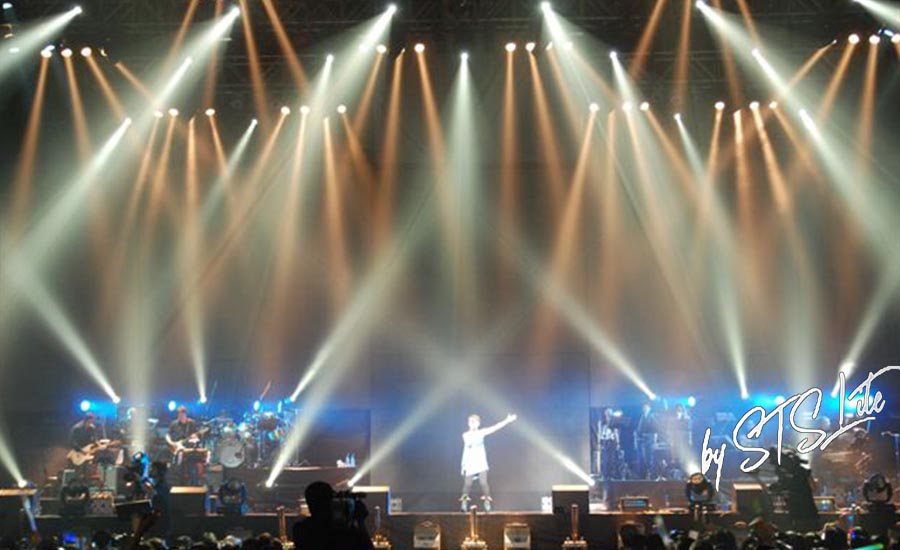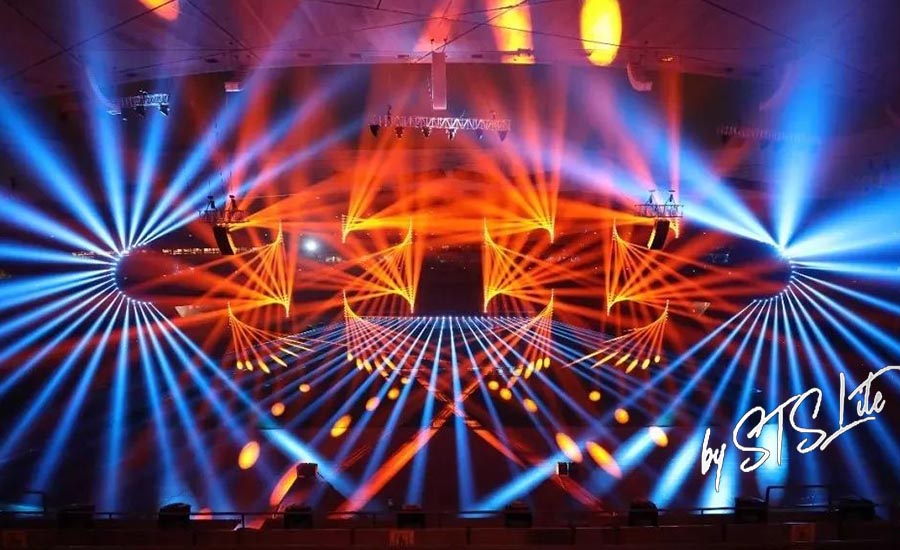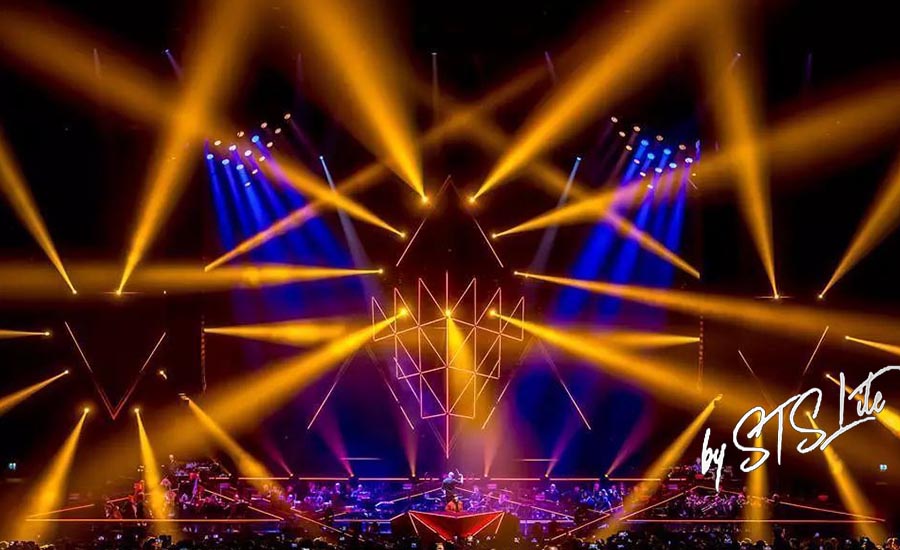Any dramatic performance, except in the outdoor daytime, requires a set of lights. If lighting is only the only function of stage lighting, as long as a group of fluorescent lamps are arranged to hang on the stage, it can provide a smooth light for actors and set props. However, obviously, stage lighting is more useful than ordinary lighting. A group of efficient stage lighting can connect the visual elements of a production and increase the fun of the audience.

What is "stage lighting". Stage lighting has diversity and regularity. Its most important feature is that it can make the audience's emotions fluctuate with the changes of lighting colors, and can be closer to the plot and role emotion. Different lamps, color chips and angles can be arranged and combined into tens of thousands of light after changing design. It not only enriches the expression and action of actors, but also creates another time and space. Especially in creating atmosphere and strengthening mood, it has almost the same function as music, but it symbolizes and implies the plot with brightness and color. Taking words as an example, actors and scenery are real pens, and light is empty pens. Designers should use their brains and technology to express abstract adjectives such as "melancholy", "sad and angry". Therefore, when you watch a play, you can understand the season, climate and time in the play and the emotional changes of the characters from the tone and brightness of the stage without narration and lines. Generally speaking, comedies use warm colors, while tragedies use cool colors. Of course, the shadow without tone is also an excellent way of expression, and the director's idea of light is actually one of the main factors for him to maintain the consistent style of the whole play. Generally speaking, dim light is used in tragedy and horror films, and bright light is a warm and optimistic theme.
Function of light. Selective visibility and concentration: in the theater, we often use a sentence to describe the role of light: "we only show the audience what we want to show them". We highlight what we want to show the audience and leave the rest in the dark; Therefore, selective visibility means that the lighting makes hierarchical and selective lighting according to the stage location or the importance of characters. Lighting is a searchlight that can lead the audience to find the key points at any time during the performance.
Present the set space-time conditions: in some scenes, conditions related to space-time have been prompted or implied. For example, this play takes place in the morning or afternoon of a certain day in a certain month of a certain year, and the real time in these drama time and space has become the basic conditions that lighting design can follow, so as to determine the direction and color of relevant light sources, such as the effect of creating afternoon sunshine by lighting, the effect of winter morning, or the effect of autumn deciduous maple red, etc.
Color the stage picture to set the atmosphere (emotion): the stage space is a canvas, and the stage, scenery, clothing and other objects will not be visible without light. Therefore, light is the director's and designer's tools, brushes and pigments to color the stage picture bit by bit. This has two meanings: one is that the setting and clothing are seen by the audience and show its original color; The other is the color of the light itself, which can create a certain atmosphere and effect on the stage; For a simple example, the colored light of a lamp is often divided into two systems: one is cold light and the other is warm light. The cold light is mainly blue, while the warm light is yellow or red. They can create different sensory feelings respectively. The setting of this basic feeling and atmosphere can help actors perform and act on the stage, This is an effect achieved by stage lighting.
Shaping space and form: stage lighting can clearly cut the stage space, separate each performance area, as well as the levels of background, mid shot and foreground, present the depth of field of the stage and achieve a complete visual effect. Moreover, lighting also plays a very important role in the use of space in different theater forms.

How to make lights. Performing art attaches the most importance to practical experience, so those who study the art of lighting, in addition to learning theory and the use of tools in the classroom, practical experience accounts for a great deal of weight. The novice is like a little apprentice, adjusting the angle, loading color paper and so on. Through the actual operation, to continuously accumulate experience. The first step of stage lighting design is, of course, to read the script! However, the reading focus and angle are different from those of actors. They must practice to see the scenes and the emotional changes of the whole play, find out the turning point and transform it into the rhythm, intensity and color of light. Because the design is such an abstract performing art, most designers believe that the most important thing in learning is to understand life. Everything in life is worth and must be paid attention to and concerned. You can dabble in music, art, history or Chinese poetry, ancient paintings and so on in your personal life. In fact, the absorption of information and the observation of works are very important. Lighting design must discuss with the director, dance beauty design and makeup artist to further communicate and compromise for the unity of interpretation angle. Rehearsal, of course, can not be absent. Each gesture, expression and look must be familiar as a performer in order to accurately replace the emotion to be expressed with light. With the preparation of software, we must also understand the lamps, lamp types, space, height and equipment of the performance venue, so that the design will not be impractical. The perfect performance involves the overall cooperation. In particular, the behind the scenes workers perform on the whole stage. As soon as the curtain is opened, the set, lighting and sound effects have begun to perform. It is even more important to link them together and allow no loss. Technical rehearsal is related to the performance quality, especially for lighting. During rehearsal, he can understand whether the atmosphere and effect he wants are appropriate or insufficient in the actual exercise, and try to modify it again. In addition to the difficulties before the performance, there are also situations during the performance. Because operating computer switches and lighting hubs in actual performances is a rather boring job after all, it is more necessary to cheer up and avoid mistakes.
What kind of state is the target pursued by a lighting designer? Simplicity is beauty; Don't stress fancy and dominate, set off the theme without self-expression; A good designer is one who can set off the atmosphere and spirit and let the audience naturally accept and melt in without feeling its existence. The highest ideal is to return to nature, not to remind people of the existence of lights with many changes and colors. Of course, the color may be more and more abstract, but the audience feels real and has more profound emotional expression. Perhaps this is related to the basic abstract character such as lighting design and application. As for the novice in this work, the most important thing is to have ambition. In addition to various dabbling and efforts, we also have to cultivate patience, sensibility and care, because these three factors are the most important factors from installation to demolition, from feeling the plot to design. Different from other arts, lighting design is an artistic expression that most directly learns from nature, but needs the longest rumination to play and create. This rumination not only refers to the cultivation of designers themselves, but also includes scientific and technological research and innovation. In addition to the sense of achievement, where is the charm of lighting? Maybe just as a senior in the lighting industry said - it's like life. You can't go back and start again. You have to constantly look for beauty from mistakes and regrets!
Lighting production process. Lighting design: be familiar with the script: you must understand the content of the performance itself, do analysis work, deeply understand the characteristics of the performance, find out the turning point of the plot atmosphere, and determine the effect of each paragraph according to the script; Fixed lighting: participate in rehearsal from time to time, understand the performance content and location, determine the lighting change point, creative concept and effect after repeated discussion with the director, actors, music, clothing and other departments, determine the first draft of lighting, and issue the first draft after repeated correction. The final version can be changed at any time according to the performance situation before the actual performance; Circuit configuration: explore the performance site, and design and configure the circuit according to its circuit line, control panel, lamps and instruments, number of stage light poles, space height dimension, stage depth, length and width, and relevant mechanical equipment, such as dimmer controller; Delivery to the dance Supervisor: deliver the final lighting to the dance supervisor, determine each step of the process, determine the details of lighting effect with the actors, and inform them of their change points in detail; Sorting equipment: prepare the required equipment in advance according to the lighting configuration and the equipment of the rented site, such as color chips, color chip clips, tools, etc; Scheduling process: before entering the theater, clearly calculate the required working time according to the whole work content of the lighting itself, and plan the work process with other stage departments to avoid mutual influence on the progress.

Lighting execution: assemble lamps: Hang lamps, configure circuits, color films and adjust the angle of lamps according to the circuit configuration table; Determine the effect: determine the light brightness with the director. Determine each effect and record it in detail; Rehearsal drill: the rehearsal is regarded as formal, and the rehearsal process of the performance will not be interrupted. Problems will be raised and discussed after the rehearsal. Before the performance, strive for time, follow the actual practice of each effect recorded according to the light change table, and find out the possible problems in operation; Perform the performance: accurately perform each effect according to the instructions of the dance supervisor.
Install the stage to the performance. Hang the lights. After entering the theater, the first thing is to hang all the lights on the lamp posts one by one according to the light position shown in the light diagram. Note that the stage must be clear at this time; Each lamp in the distribution circuit must be equipped with an extension line according to the drawing and inserted into the lighting circuit; All lamps and lanterns must be adjusted to the required location one by one by the lighting design command staff, adjusted according to the size of the demand, and finally added with the specified color paper; Make a scene. After adjusting the lights, all the lights work normally. You can start making a scene. The so-called scene making is to set all kinds of light changes presented on the stage of the whole performance, and record these pictures one by one by using manual controller or computer controller, so as to become the basis for light changes in future performances; After these pictures are recorded, the technical rehearsal has to be combined with other departments, such as speakers, stage, clothing and makeup, to carry out the technical rehearsal on the stage; At this point, shortcomings can be found and corrected immediately; Problem correction: the problems occurred in the technical rehearsal must be further adjusted. Whether it is to shift the lamps, change the color paper or re adjust the lights, these are carried out in the technical rehearsal and formal rehearsal room; Formal rehearsal rehearsal is regarded as a formal performance. Usually, all possible accidents in the performance occur in advance during the formal rehearsal. Therefore, all departments, such as stage, clothing, lighting, sound effects, makeup, actors, etc., regard the rehearsal as a formal performance. The rehearsal process is never interrupted. Problems are raised and discussed after the rehearsal. Finally, after the formal rehearsal is completed, There is still some time to adjust and repair the departments, so as to wish a perfect official performance; The official performance designer has completed his work and handed over all technical work to technicians. The stage supervisor controls the technical department to complete the performance process.
Copyright © 2021 GuangZhou STS Lighting Equipment Co.,Ltd. | All Rights Reserved